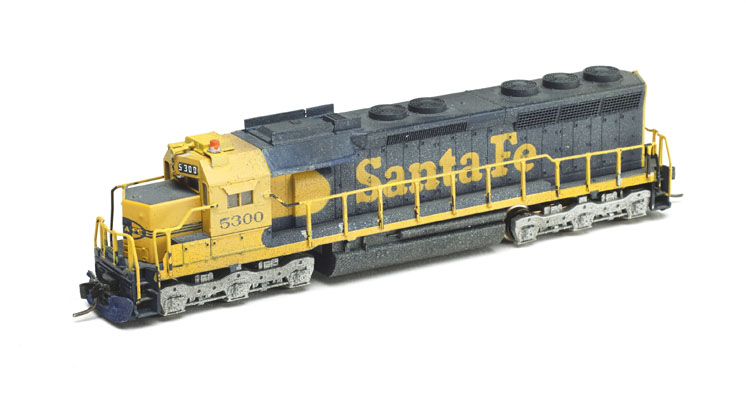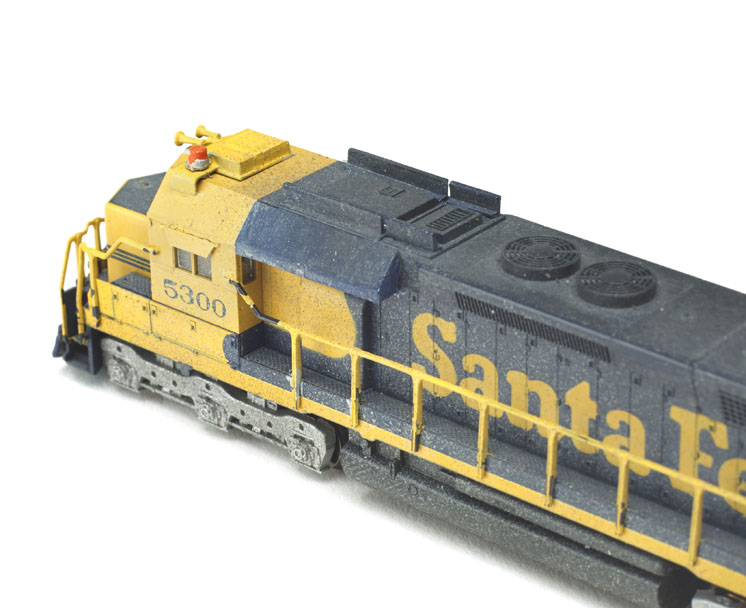
So far, almost all my work has been on ATSF units. The photo shows an N scale Kato SD45 representative of how far I want to go with each engine.
Well-known model railroader Allen McClelland is noted among many things for his “good enough” modeling philosophy, which is so helpful to maintaining your sanity if you’re building a large layout. To me, this engine is good enough, and even a little beyond. For others, though, it might not be. For me “good enough” is a relative concept, but a very important one.
The model railroading Danneman brothers, Mike and Tom, both add much more detail to their beautiful N scale diesels. They include such parts as speed recorders, rerailers, free-standing grab irons and lift rings, windshield wipers, and rear-view mirrors.

My bible for detailing Santa Fe diesels is The Santa Fe Diesel, Vol. 2: 1960-1985 by Cinthia Priest. This book is loaded with information and color photos, especially those top views you really need for detailing. But it’s out of print, hard to find, and usually priced accordingly.
Superdetailing diesels is a lot less work now than it was when I first made the eight gussied-up engines I presently own. You work less because the manufacturers in N scale are doing more.
All my detailed engines are super-running Kato units made in the 1990s. Kato has re-run them in improved versions, especially when it comes to detail. I’m thinking mostly of the SD45s and C30-7s, of which I need many.
On the earlier engines, the couplers were mounted on the trucks, meaning there were big, square holes in the pilots to allow room for the couplers to swing on curves. Micro-Trains offered kits so you could fill the hole and convert to body-mounted knuckle couplers.
One particularly aggravating problem for me was that the handrails on Santa Fe blue warbonnet hood units were unpainted black plastic castings. Dang it, they were supposed to be yellow, and anybody who’s done much airbrushing can tell you horror stories about trying to get yellow to cover black. (Hint: First you paint the item gray.)
Then, as now, most prototype road locomotives were equipped with snowplows, but not for N scale models. You had to add them. And the cabs looked naked without numbers on the numberboards.
In the mid-1990s N scalers and N scale locomotive manufacturers were just awakening to the promise of Digital Command Control. Small-enough decoders were beginning to appear, and figuring out how to install them was all the challenge a modeler could want. (I sent my frames to Aztec, which for $20 milled them for decoder installation.) Then you were out another $35 for a decoder, which if you were lucky, you’d get installed, preferably unfried, in about two hours. (The good old days, folks, are right now.)
The early ’80s were recession years and rail traffic was down. Railroads weren’t buying many new locomotives. For the ATSF, this was a fascinating time, as it rebuilt and improved many of the road engines it had on hand.
The railroad was very interested in improved performance, and one approach was to try getting fresher air to the intakes for more efficient combustion. To this end, they installed lifters alongside the exhaust stacks, the idea being that smoky exhaust would be projected farther up and away so as not to mix with the intake air.
Another addition was snow shields extending from the intake grills. These additions proved to be less effective than hoped for, and they got in the way of mechanics working on the engines. In a few years the modifications were gone.
Occasionally, I’ve searched the Internet looking for information and drawings of these experimental parts, but never found anything. I suspect the shop pretty much winged it. Sizes were determined by where the pieces were going to fit.
I made my lifters from Evergreen 1⁄8″ channel, cutting off one flange to make an L-shaped cross section. The snow shields were made from styrene and project at a 45 degree angle. They rather resemble kitchen range hoods.
Learning about these special features and representing them is to me one of the great pleasures of the hobby. I love the Santa Fe, but I suspect most every road had its way of doing certain things, and learning about them can make your own enjoyment of the hobby, and detailing N scale diesels, even better.














Agreed with Geoffrey. Plus, Miniatures by Eric makes the part for snowshields, no need to scratchbuild unless you want to save a couple dollars.
I appreciate ANY article on N scale, but I'm a bit disappointed that other than the helpful tip on painting handrails there was little in the article to learn from, unless you model the Santa Fe. Sorry, but it left me wanting more.
I agree… I go for the extra details on the engines, whether they were steam or diesel.
I really enjoyed this article, I've learned a lot from Mr.Kelly since moving into n scale and enjoy his easy,down to earth writting style, but most I really enjoy reading articles like this on locomotive detailing. Well done!
Jim, can't agree with you more. A little detail goes a long way. Sometimes it is even only a one or two night project, but definitely adds to the model and realism.